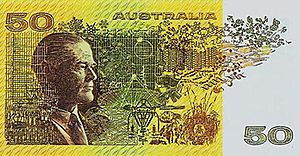Ian Clunies Ross facts for kids
Quick facts for kids
Ian Clunies Ross
|
|
|---|---|

Clunies Ross circa 1950
|
|
| Born | 22 February 1899 Bathurst, New South Wales, Australia
|
| Died | 20 June 1959 (aged 60) Victoria, Australia
|
| Nationality | Australian |
| Education | Newington College University of Sydney |
| Occupation | Veterinary scientist |
| Title | Chairman CSIRO |
| Spouse(s) | Janet Carter |
| Children | 3 |
| Awards | James Cook Medal (1956) |
Sir William Ian Clunies Ross was a very important Australian veterinary scientist. He lived from 1899 to 1959. Many people say he helped create Australia's big science boom. This was because he led the CSIRO. The CSIRO is Australia's main science organization.
Contents
Early Life and Family
Ian Clunies Ross was born in Bathurst, New South Wales, Australia. His birthday was February 22, 1899. On October 6, 1927, he married Janet Leslie Carter in Sydney. They had three sons: Anthony, Adrian, and David.
His Education
Ian Clunies Ross went to Newington College from 1912 to 1916. In 1917, he started studying agriculture at the University of Sydney. The next year, he switched to Veterinary Science. He finished his degree in 1920.
During his studies, his family faced tough times. His father passed away in 1914. His brothers, Egerton and Rob, died during World War I. One was killed in action, and the other died from a serious illness.
Working with Animals
In 1921, Ian Clunies Ross became a temporary teacher of animal anatomy. The next year, he received a special fellowship. This allowed him to travel and study overseas. He spent a year in England, working on animal parasites. He also visited the United States. There, he learned how to control parasitic diseases in the field.
When he returned to Sydney, he opened his own animal clinic. He also taught at the university. He continued his research on different parasites. These included the hydatid parasite and the liver fluke. He also studied the dog-tick. He even developed a way to protect dogs from the dog-tick.
Joining CSIR
In 1926, Ian Clunies Ross joined the new Council for Scientific and Industrial Research (CSIR). He was a parasitologist, studying parasites. He continued his research at the Sydney University Veterinary School.
By 1931, his team had grown. They moved into the CSIR's new McMaster Animal Health Laboratory. Ian Clunies Ross became the leader of this lab. In 1928, he earned his Doctor of Veterinary Science degree. His work at the McMaster Laboratory was very important. He helped control liver-fluke in sheep. This greatly improved animal health and helped farmers in the 1930s.
Leading Science in Australia
After his time at the McMaster Laboratory, Clunies Ross traveled to Asia. From 1937 to 1940, he represented Australia in London. He enjoyed this kind of leadership role. He also helped Australia at the League of Nations meeting in 1938.
When World War II started, he and his family returned to Australia. He went back to work at the University of Sydney. He also led the Australian Institute of International Affairs from 1941 to 1945. He often shared his thoughts on world events.
Chairman of CSIRO
In 1943, Ian Clunies Ross took on new roles. He helped manage scientific staff for the government. He also advised on the farming industry during the war. He kept these jobs until 1945.
After the war, he left the university. He helped the CSIR plan research on sheep and wool. In 1946, he became a full-time member of the CSIR Executive Committee. In 1949, the CSIR changed its name to CSIRO. Ian Clunies Ross became the chairman of CSIRO. He led the organization until he passed away in 1959.
During his time as chairman, he oversaw a big project. This was the release of myxomatosis to control rabbits in Australia. Rabbits were a huge problem for farmers.
He also had discussions with radio astronomer Ruby Payne-Scott. They talked about the role of women in CSIRO. They also discussed differences in pay and working conditions for male and female employees. These discussions aimed to improve fairness within the organization.
His Legacy
In 1954, Ian Clunies Ross received a special honor. He was made a knight and given the CMG award. He also became a founding member of the Australian Academy of Science.
Ian Clunies Ross is still remembered in Australia. From 1973 to 1995, his picture was on the Australian $50 banknote. A science center in Parkville, Victoria was renamed Clunies Ross House in 1968. It has a mural celebrating his work.
Honours

- Companion of the Order of St Michael and St George (January 1, 1954) for his work as Chairman of the CSIRO.
- Knight Bachelor (June 10, 1954) for his work as Chairman of the CSIRO.
Namesakes
- Clunies Ross National Science and Technology Award.
- Clunies Ross Street in Canberra, Australian Capital Territory, Australia.
- Clunies Ross Street in Prospect, New South Wales, Australia.
- Clunies Ross Court in Brisbane Technology Park, Eight Mile Plains, Queensland, Australia.
- Clunies Ross Award or ATSE Clunies Ross Award (started in 1959).
- Clunies Ross House at Newington College.
- Ian Clunies Ross lecture theatre at the University of Sydney's School of Veterinary Science.

